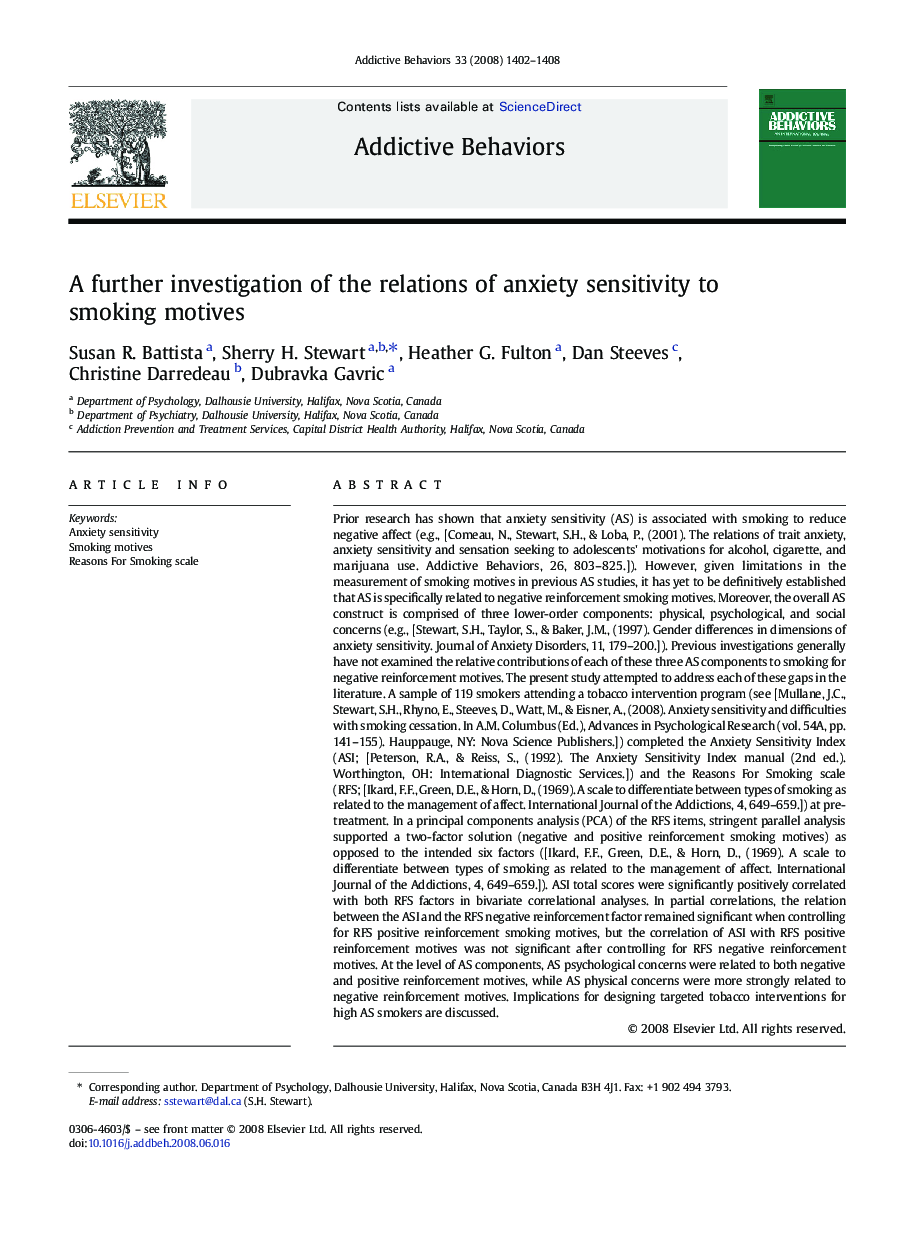| کد مقاله | کد نشریه | سال انتشار | مقاله انگلیسی | نسخه تمام متن |
|---|---|---|---|---|
| 900486 | 915448 | 2008 | 7 صفحه PDF | دانلود رایگان |

Prior research has shown that anxiety sensitivity (AS) is associated with smoking to reduce negative affect (e.g., [Comeau, N., Stewart, S.H., & Loba, P., (2001). The relations of trait anxiety, anxiety sensitivity and sensation seeking to adolescents' motivations for alcohol, cigarette, and marijuana use. Addictive Behaviors, 26, 803–825.]). However, given limitations in the measurement of smoking motives in previous AS studies, it has yet to be definitively established that AS is specifically related to negative reinforcement smoking motives. Moreover, the overall AS construct is comprised of three lower-order components: physical, psychological, and social concerns (e.g., [Stewart, S.H., Taylor, S., & Baker, J.M., (1997). Gender differences in dimensions of anxiety sensitivity. Journal of Anxiety Disorders, 11, 179–200.]). Previous investigations generally have not examined the relative contributions of each of these three AS components to smoking for negative reinforcement motives. The present study attempted to address each of these gaps in the literature. A sample of 119 smokers attending a tobacco intervention program (see [Mullane, J.C., Stewart, S.H., Rhyno, E., Steeves, D., Watt, M., & Eisner, A., (2008). Anxiety sensitivity and difficulties with smoking cessation. In A.M. Columbus (Ed.), Advances in Psychological Research (vol. 54A, pp. 141–155). Hauppauge, NY: Nova Science Publishers.]) completed the Anxiety Sensitivity Index (ASI; [Peterson, R.A., & Reiss, S., (1992). The Anxiety Sensitivity Index manual (2nd ed.). Worthington, OH: International Diagnostic Services.]) and the Reasons For Smoking scale (RFS; [Ikard, F.F., Green, D.E., & Horn, D., (1969). A scale to differentiate between types of smoking as related to the management of affect. International Journal of the Addictions, 4, 649–659.]) at pre-treatment. In a principal components analysis (PCA) of the RFS items, stringent parallel analysis supported a two-factor solution (negative and positive reinforcement smoking motives) as opposed to the intended six factors ([Ikard, F.F., Green, D.E., & Horn, D., (1969). A scale to differentiate between types of smoking as related to the management of affect. International Journal of the Addictions, 4, 649–659.]). ASI total scores were significantly positively correlated with both RFS factors in bivariate correlational analyses. In partial correlations, the relation between the ASI and the RFS negative reinforcement factor remained significant when controlling for RFS positive reinforcement smoking motives, but the correlation of ASI with RFS positive reinforcement motives was not significant after controlling for RFS negative reinforcement motives. At the level of AS components, AS psychological concerns were related to both negative and positive reinforcement motives, while AS physical concerns were more strongly related to negative reinforcement motives. Implications for designing targeted tobacco interventions for high AS smokers are discussed.
Journal: Addictive Behaviors - Volume 33, Issue 11, November 2008, Pages 1402–1408